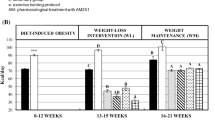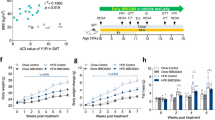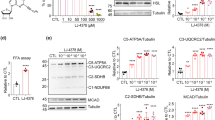Abstract
Objective:
The severity of obesity is often more determined by the distribution of fat depots rather than by body weight itself. Therefore, the effect of rimonabant on fat distribution pattern was investigated in female candy-fed Wistar rats.
Design:
Female Wistar rats were fed a high fat, high carbohydrate (candy-) diet for 12 weeks. During the last 6 weeks rats were treated with rimonabant. Food intake and body weight development were investigated, as well as effects on total body fat, especially visceral fat and ectopic lipid accumulation in skeletal muscle and liver, determined by in vivo magnetic resonance imaging/magnetic resonance spectroscopy.
Results:
Candy-diet increased body weight, which was predominantly due to the increased total fat mass with predominance of visceral fat accumulation. Treatment with rimonabant fully reversed the weight gain and fat deposition in the visceral cavity and skeletal muscle, in contrast to pair feeding. In spite of an only transient reduction of food intake, body weight reduction, as well as normalized body fat, reduced visceral fat and intramyocellular lipids were maintained over the treatment period.
Conclusions:
We conclude that additional factors other than reduced caloric intake must be responsible for the improvements in these lipid parameters. The complete cluster of results is consistent with increased lipid oxidation caused by rimonabant.
This is a preview of subscription content, access via your institution
Access options
Subscribe to this journal
Receive 12 print issues and online access
$259.00 per year
only $21.58 per issue
Buy this article
- Purchase on Springer Link
- Instant access to full article PDF
Prices may be subject to local taxes which are calculated during checkout





Similar content being viewed by others
References
Haslam DW, James WP . Obesity. Lancet 2005; 366/9492: 1197–1209.
Hedley AA, Ogden CL, Johnson CL, Carroll MD, Curtin LR, Flegal KM . Prevalence of overweight and obesity among US children, adolescents, and adults, 1999–2002. JAMA 2004; 291/23: 2847–2850.
Prentice AM . The emerging epidemic of obesity in developing countries. Int J Epidemiol 2006; 35/1: 93–99.
Grundy SM, Brewer Jr HB, Cleeman JI, Smith Jr SC, Lenfant C . Definition of metabolic syndrome: Report of the National Heart, Lung, and Blood Institute/American Heart Association conference on scientific issues related to definition. Circulation 2004; 109/3: 433–438.
Cooke D, Bloom S . The obesity pipeline: current strategies in the development of anti-obesity drugs. Nat Rev Drug Discov 2006; 5/11: 919–931.
Despres JP, Moorjani S, Lupien PJ, Tremblay A, Nadeau A, Bouchard C . Regional distribution of body fat, plasma lipoproteins, and cardiovascular disease. Arteriosclerosis 1990; 10/4: 497–511.
Despres JP, Lemieux I . Abdominal obesity and metabolic syndrome. Nature 2006; 444/7121: 881–887.
Lean ME, Han TS, Morrison CE . Waist circumference as a measure for indicating need for weight management. BMJ 1995; 311/6998: 158–161.
Hofbauer KG, Nicholson JR, Boss O . The obesity epidemic: current and future pharmacological treatments. Annu Rev Pharmacol Toxicol 2007; 47: 565–592.
Aronne LJ . Is rimonabant a safe and effective treatment for obesity? Nat Clin Pract Endocrinol Metab 2007; 3/5: 388–389.
Rinaldi-Carmona M, Barth F, Heaulme M, Shire D, Calandra B, Congy C et al. SR141716A, a potent and selective antagonist of the brain cannabinoid receptor. FEBS Lett 1994; 350/2–3: 240–244.
Despres JP, Golay A, Sjostrom L . Effects of rimonabant on metabolic risk factors in overweight patients with dyslipidemia. N Engl J Med 2005; 353/20: 2121–2134.
Hollander P . Endocannabinoid blockade for improving glycemic control and lipids in patients with type 2 diabetes mellitus. Am J Med 2007; 120/2 (Suppl 1): S18–S28.
Pi-Sunyer FX, Aronne LJ, Heshmati HM, Devin J, Rosenstock J . Effect of rimonabant, a cannabinoid-1 receptor blocker, on weight and cardiometabolic risk factors in overweight or obese patients: RIO-North America: a randomized controlled trial. JAMA 2006; 295/7: 761–775.
Van Gaal LF, Rissanen AM, Scheen AJ, Ziegler O, Rossner S . Effects of the cannabinoid-1 receptor blocker rimonabant on weight reduction and cardiovascular risk factors in overweight patients: 1-year experience from the RIO-Europe study. Lancet 2005; 365/9468: 1389–1397.
Jamshidi N, Taylor DA . Anandamide administration into the ventromedial hypothalamus stimulates appetite in rats. Br J Pharmacol 2001; 134/6: 1151–1154.
Tucci SA, Rogers EK, Korbonits M, Kirkham TC . The cannabinoid CB1 receptor antagonist SR141716 blocks the orexigenic effects of intrahypothalamic ghrelin. Br J Pharmacol 2004; 143/5: 520–523.
Di Marzo V, Matias I . Endocannabinoid control of food intake and energy balance. Nat Neurosci 2005; 8/5: 585–589.
Kirkham TC, Williams CM, Fezza F, Di Marzo V . Endocannabinoid levels in rat limbic forebrain and hypothalamus in relation to fasting, feeding and satiation: stimulation of eating by 2-arachidonoyl glycerol. Br J Pharmacol 2002; 136/4: 550–557.
Melis T, Succu S, Sanna F, Boi A, Argiolas A, Melis MR . The cannabinoid antagonist SR 141716A (rimonabant) reduces the increase of extra-cellular dopamine release in the rat nucleus accumbens induced by a novel high palatable food. Neurosci Lett 2007; 419/3: 231–235.
Bensaid M, Gary-Bobo M, Esclangon A, Maffrand JP, Le Fur G, Oury-Donat F et al. The cannabinoid CB1 receptor antagonist SR141716 increases Acrp30 mRNA expression in adipose tissue of obese fa/fa rats and in cultured adipocyte cells. Mol Pharmacol 2003; 63/4: 908–914.
Poirier B, Bidouard JP, Cadrouvele C, Marniquet X, Staels B, O'Connor SE et al. The anti-obesity effect of rimonabant is associated with an improved serum lipid profile. Diabetes Obes Metab 2005; 7/1: 65–72.
Ravinet Trillou C, Arnone M, Delgorge C, Gonalons N, Keane P, Maffrand JP et al. Anti-obesity effect of SR141716, a CB1 receptor antagonist, in diet-induced obese mice. Am J Physiol Regul Integr Comp Physiol 2003; 284/2: 345–353.
Doyon C, Denis RG, Baraboi ED, Samson P, Lalonde J, Deshaies Y et al. Effects of rimonabant (SR141716) on fasting-induced hypothalamic-pituitary-adrenal axis and neuronal activation in lean and obese Zucker rats. Diabetes 2006; 55/12: 3403–3410.
Vickers SP, Webster LJ, Wyatt A, Dourish CT, Kennett GA . Preferential effects of the cannabinoid CB1 receptor antagonist, SR 141716, on food intake and body weight gain of obese (fa/fa) compared to lean Zucker rats. Psychopharmacology (Berl) 2003; 167/1: 103–111.
Herling AW, Kilp S, Elvert R, Haschke G, Kramer W . Increased energy expenditure contributes more to the body weight-reducing effect of rimonabant than reduced food intake in candy-fed wistar rats. Endocrinology 2008; 149/5: 2557–2566.
Kunnecke B, Verry P, Benardeau A, von KM . Quantitative body composition analysis in awake mice and rats by magnetic resonance relaxometry. Obes Res 2004; 12/10: 1604–1615.
Kuhlmann J, Neumann-Haefelin C, Belz U, Kalisch J, Juretschke HP, Stein M et al. Intramyocellular lipid and insulin resistance: a longitudinal in vivo 1H-spectroscopic study in Zucker diabetic fatty rats. Diabetes 2003; 52/1: 138–144.
Bergmeyer HU . Methoden der Enzymatischen Analyse. Verlag Chemie: Weinheim, 1974.
Beha A, Juretschke HP, Kuhlmann J, Neumann-Haefelin C, Belz U, Gerl M et al. Muscle type-specific fatty acid metabolism in insulin resistance: an integrated in vivo study in Zucker diabetic fatty rats. Am J Physiol Endocrinol Metab 2006; 290/5: E989–E997.
Neumann-Haefelin C, Beha A, Kuhlmann J, Belz U, Gerl M, Quint M et al. Muscle-type specific intramyocellular and hepatic lipid metabolism during starvation in Wistar rats. Diabetes 2004; 53/3: 528–534.
Raun K, von VP, Gotfredsen CF, Golozoubova V, Rolin B, Knudsen LB . Liraglutide, a long-acting glucagon-like peptide-1 analog, reduces body weight and food intake in obese candy-fed rats, whereas a dipeptidyl peptidase-IV inhibitor, vildagliptin, does not. Diabetes 2007; 56/1: 8–15.
Savage DB, Petersen KF, Shulman GI . Disordered lipid metabolism and the pathogenesis of insulin resistance. Physiol Rev 2007; 87/2: 507–520.
Krssak M, Falk Petersen K, Dresner A, DiPietro L, Vogel SM, Rothman DL et al. Intramyocellular lipid concentrations are correlated with insulin sensitivity in humans: a 1H NMR spectroscopy study. Diabetologia 1999; 42/1: 113–116.
Arner P . Regional adipocity in man. J Endocrinol 1997; 155/2: 191–192.
Jbilo O, Ravinet-Trillou C, Arnone M, Buisson I, Bribes E, Peleraux A et al. The CB1 receptor antagonist rimonabant reverses the diet-induced obesity phenotype through the regulation of lipolysis and energy balance. FASEB J 2005; 19/11: 1567–1569.
McGarry JD . Banting lecture 2001: dysregulation of fatty acid metabolism in the etiology of type 2 diabetes. Diabetes 2002; 51/1: 7–18.
McGarry JD, Mills SE, Long CS, Foster DW . Observations on the affinity for carnitine, and malonyl-CoA sensitivity, of carnitine palmitoyltransferase I in animal and human tissues. Demonstration of the presence of malonyl-CoA in non-hepatic tissues of the rat. Biochem J 1983; 214/1: 21–28.
McGarry JD, Brown NF . The mitochondrial carnitine palmitoyltransferase system. From concept to molecular analysis. Eur J Biochem 1997; 244/1: 1–14.
Author information
Authors and Affiliations
Corresponding author
Rights and permissions
About this article
Cite this article
Herling, A., Kilp, S., Juretschke, HP. et al. Reversal of visceral adiposity in candy-diet fed female Wistar rats by the CB1 receptor antagonist rimonabant. Int J Obes 32, 1363–1372 (2008). https://doi.org/10.1038/ijo.2008.105
Received:
Revised:
Accepted:
Published:
Issue Date:
DOI: https://doi.org/10.1038/ijo.2008.105
Keywords
This article is cited by
-
Multiple endocannabinoid-mediated mechanisms in the regulation of energy homeostasis in brain and peripheral tissues
Cellular and Molecular Life Sciences (2019)
-
Re-visiting the Endocannabinoid System and Its Therapeutic Potential in Obesity and Associated Diseases
Current Diabetes Reports (2017)
-
Effect of the Cannabinoid Receptor-1 Antagonist Rimonabant on Inflammation in Mice With Diet-Induced Obesity
Obesity (2011)
-
Acute cannabinoid receptor type 1 (CB1R) modulation influences insulin sensitivity by an effect outside the central nervous system in mice
Diabetologia (2011)
-
Food Intake-independent Effects of CB1 Antagonism on Glucose and Lipid Metabolism
Obesity (2009)



